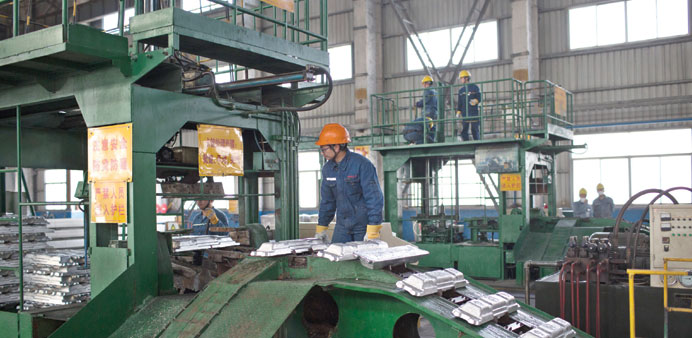An employee watches aluminium ingots moving on a conveyor belt at a smelting facility in Zouping. The National Bureau of Statistics and China Federation of Logistics and Purchasing said yesterday the country’s manufacturing gauge fell to an eight-month low in February.
Bloomberg
A Chinese manufacturing gauge fell to an eight-month low in February, adding to challenges for growth as Premier Li Keqiang prepares to map out the government’s economic strategy to the nation’s legislature.
The Purchasing Managers’ Index was at 50.2, the National Bureau of Statistics and China Federation of Logistics and Purchasing said yesterday in Beijing. That compared with January’s 50.5 reading and the 50.1 median analyst estimate in a Bloomberg News survey. A number above 50 signals expansion.
Yesterday’s data underscore the challenges facing the government as it tries to sustain expansion above Li’s 7% bottom line while implementing policies to rein in credit and overcapacity. The yuan’s biggest decline on record against the dollar in February may add to investor concerns that the economy is vulnerable to financial risks.
“The slowdown in manufacturing growth is due to a deceleration in investment, especially of credit-sensitive infrastructure and real-estate investment,” said Louis Kuijs, chief China economist at Royal Bank of Scotland in Hong Kong. “But there’s no need to become overly concerned – the government has the policy space it needs to ensure its bottom line on growth this year while retaining financial stability.”
China’s benchmark stock index slumped 2.7% this week, the biggest drop in seven weeks, amid concerns economic expansion will ease as banks tame lending and a weaker yuan spurs capital outflows.
The currency slid as much as 0.9% on Friday, the largest decline since China unified official and market exchange rates in 1994, according to data compiled by Bloomberg. The yuan lost 1.3% in February, the biggest monthly drop on record, fuelled by speculation the central bank will widen the currency’s trading band against the dollar to allow greater volatility at a time when economic growth is slowing.
The yuan’s fall, along with the recent drop in interbank interest rates and bond yields, “should be overall positive for growth,” even though the declines are more related to the central bank’s financial reform efforts, Lu Ting and Zhi Xiaojia, Hong Kong-based economists at Bank of America Corp wrote in a report yesterday.
Premier Li will present his first annual work report to the National People’s Congress in Beijing on March 5, outlining the government’s plans for the economy after the ruling Communist Party set out its blueprint for reform at a summit in November. He will also announce a target for this year’s increase in gross domestic product.
If the goal is unchanged from last year’s 7.5%, “the government will have to roll out pro-growth policies, which will then delay the long-awaited structural reforms,” Australia & New Zealand Banking Group economists led by Hong Kong-based Liu Li-Gang said in a report yesterday. “While low interest rates could help the corporates and exporters, they could fuel the shadow banking activities again.”
Economic expansion will ease to 7.5% this year from 7.7% in 2013, according to the median analyst estimate in a Bloomberg survey carried out from February 14 to February 19. That would be the weakest pace since 1990, reflecting the impact of government efforts to rein in surging credit, curb overcapacity and pursue longer-term policies to protect the environment and shift to a consumption-based growth model.
The government’s PMI is based on responses to questionnaires sent to purchasing executives of 3,000 companies. Estimates in a Bloomberg survey of 33 analysts ranged from a reading of 49.5 to 51.5.
In yesterday’s report, a gauge of output slipped to 52.6 in February from 53 the previous month, while a sub-index of new orders dropped to 50.5 from 50.9. A measure of new export orders had a below-50 reading for the third straight month, indicating a contraction.
The PMI for large companies fell to 50.7 from 51.4 the previous month. The gauges for small and medium-sized enterprises showed a contraction, in line with the preliminary reading of a separate manufacturing gauge released on February 20 by HSBC Holdings and Markit Economics.
Indian business angel group makes first investment in UK start-up
India’s largest business angels group has made its first investment in a UK start-up, investing in a London-based company SwiftShift. The amount was not disclosed. The Indian Angel Network (IAN) is Asia’s largest angel network of over 250 investors spread across 10 countries. Effectively, this is an Indian angel network investing in a UK company run by an Israeli in London. SwiftShift allows companies to quickly fill short notice shifts using their own staff through SMS, email, and mobile technology.
The Indian Angel Network decided to invest in SwiftShift following a pitching session in London organised by UKTI where 7 companies presented to the investors. According to UK government figures Indian firms are now the 5th largest investors in the UK.


